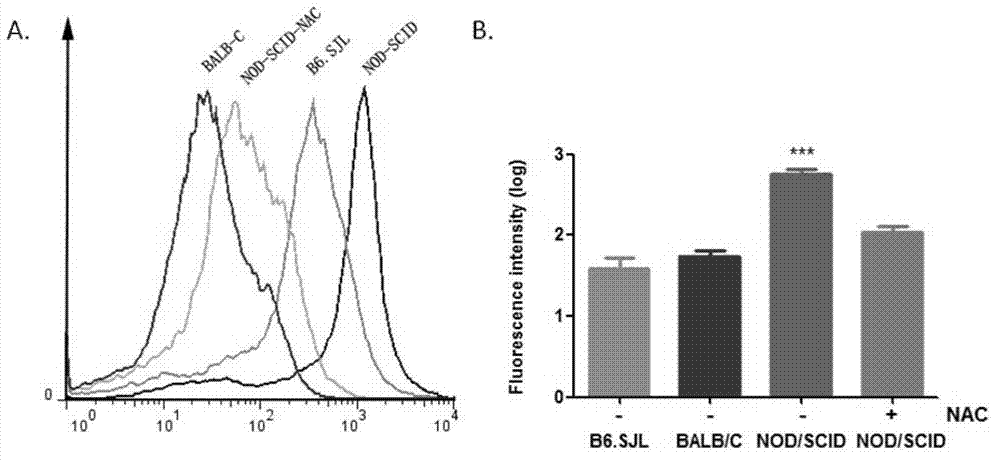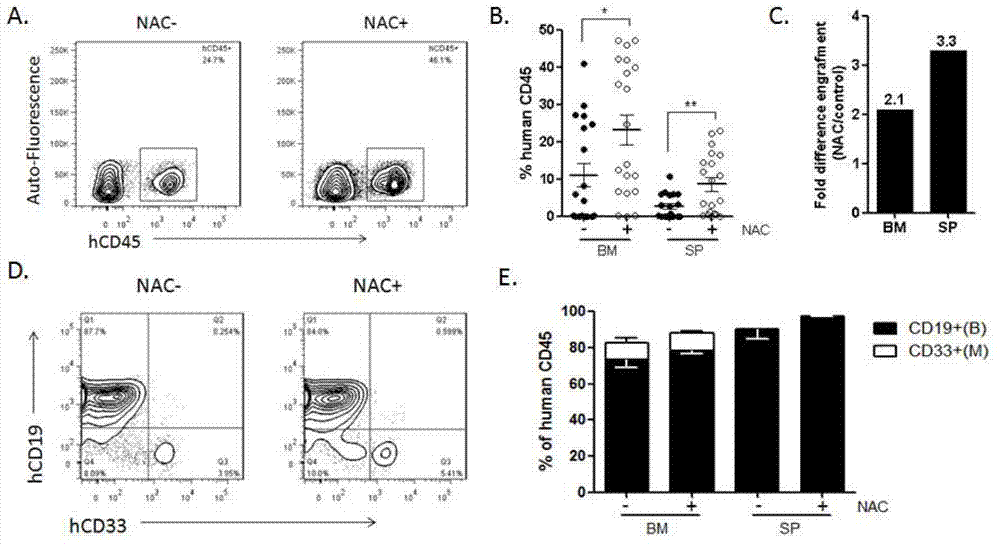Method for constructing immunodeficiency mouse transplant model of human stem cells
A construction method and immunodeficiency technology, applied in the fields of medical science, veterinary instruments, veterinary surgery, etc., can solve the problems of being unsuitable for clinical and scientific research experiments, hindering the implantation and survival of human hematopoietic stem cells, and the microenvironment of hematopoietic hematopoietic stem cells Unclear and other problems, to achieve the effect of simple and easy implementation, low price, and less trauma
- Summary
- Abstract
- Description
- Claims
- Application Information
AI Technical Summary
Problems solved by technology
Method used
Image
Examples
Embodiment 1
[0026] A method for constructing an immunodeficiency mouse (NOD / SCID) transplantation model of human stem cells (the method for improving the implantation rate of human stem cells in an immunodeficiency mouse transplantation model), comprising the steps of:
[0027] 1) Take 8-week-old NOD / SCID mice, female, and raise them in an SPF-grade sterile room. The feed, drinking water, and litter are all autoclaved, and the antioxidant N-acetylcysteine (100mg / kg) the mice in the experimental group were injected intraperitoneally, once every other day, and N-acetylcysteine was added to the drinking water of the mice in the experimental group at the same time, and the concentration of N-acetylcysteine was 1 mg / ml to reduce the Reactive oxygen species levels in the mouse bone marrow, the recipient mice 137 Cs source sublethal dose irradiation, dose 2.0Gy, dose rate 0.7Gy / min, the collected human CD34+ cells were transplanted through the tail vein of the mice within 24 hours after t...
Embodiment 2
[0034] A method for constructing an immunodeficiency mouse (NOD / SCID) transplantation model of human stem cells (the method for improving the implantation rate of human stem cells in an immunodeficiency mouse transplantation model), comprising the steps of:
[0035] 1) Take 8-week-old NOD / SCID mice, female, and raise them in an SPF-grade sterile room. The feed, drinking water, and litter are all autoclaved, and the antioxidant N-acetylcysteine (100mg / kg) the mice in the experimental group were injected intraperitoneally, once every other day, and N-acetylcysteine was added to the drinking water of the mice in the experimental group at the same time, and the concentration of N-acetylcysteine was 1 mg / ml to reduce the Reactive oxygen species levels in the mouse bone marrow, the recipient mice 137 Cs source sublethal dose irradiation, dose 2.0Gy, dose rate 0.7Gy / min, the mice were anesthetized by intraperitoneal injection of pentobarbital sodium (50mg / kg) within 24 hours a...
Embodiment 3
[0044] Using the method of limiting dilution, the number of transplanted cells in Example 2 and Comparative Example 2 was changed, and other conditions remained unchanged, and the number of transplanted cells was: 100, 50, 20, and 10 cells / group. Such as Figure 4 As shown, according to the principle of Poisson distribution, after treatment with the antioxidant N-acetylcysteine, NOD / SCID mice were injected with tibial bone marrow (IT), contralateral bone marrow (BM) and spleen (SP). The probabilities of human SCID-repopulating cells (SRC) were: 1 / 36, 1 / 50, 1 / 57; for the control group: 1 / 108, 1 / 203, 1 / 448. It shows that NOD / SCID mice treated with antioxidants are 3.0, 4.1 and 7.9 times more sensitive for detecting human SCID replantation cells, respectively.
PUM
 Login to View More
Login to View More Abstract
Description
Claims
Application Information
 Login to View More
Login to View More - R&D
- Intellectual Property
- Life Sciences
- Materials
- Tech Scout
- Unparalleled Data Quality
- Higher Quality Content
- 60% Fewer Hallucinations
Browse by: Latest US Patents, China's latest patents, Technical Efficacy Thesaurus, Application Domain, Technology Topic, Popular Technical Reports.
© 2025 PatSnap. All rights reserved.Legal|Privacy policy|Modern Slavery Act Transparency Statement|Sitemap|About US| Contact US: help@patsnap.com



